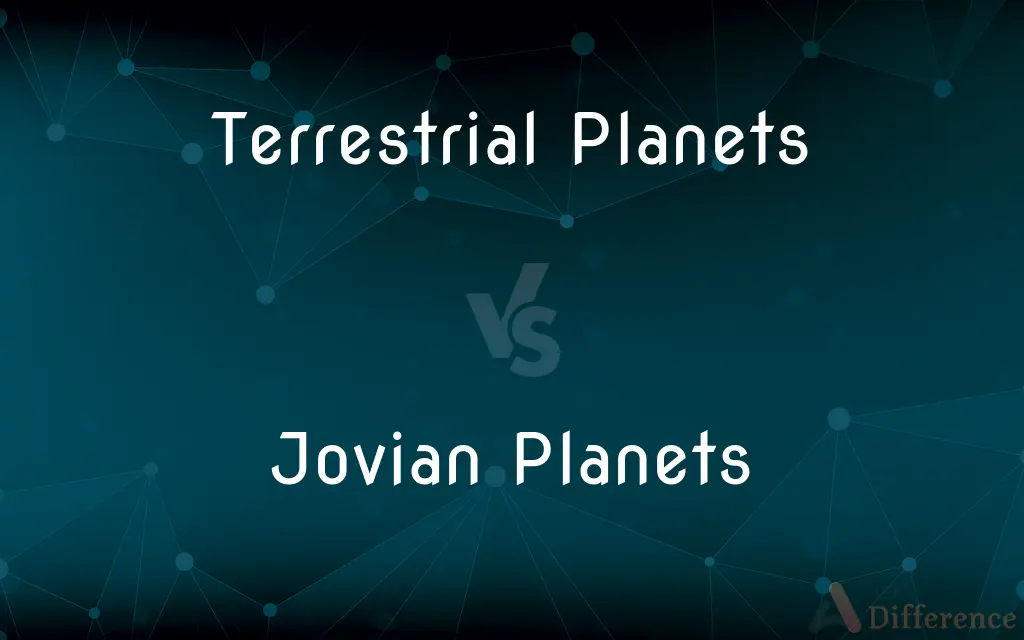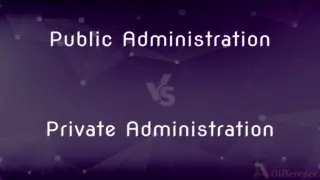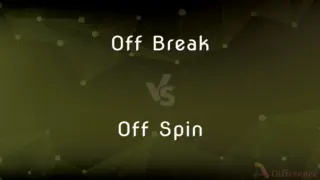Terrestrial Planets vs. Jovian Planets — What's the Difference?
By Tayyaba Rehman — Published on November 18, 2023
Terrestrial planets are rocky, inner planets; Jovian planets are gaseous, outer giants.

Difference Between Terrestrial Planets and Jovian Planets
Table of Contents
ADVERTISEMENT
Key Differences
Terrestrial planets are the innermost planets in our solar system and primarily consist of rock and metal. Jovian planets, also called gas giants, lie farther out in the solar system and are mostly composed of hydrogen and helium.
The size and mass of Terrestrial planets are relatively smaller when compared to Jovian planets. While Terrestrial planets like Earth and Mars have solid surfaces and thinner atmospheres, Jovian planets like Jupiter and Saturn possess thick atmospheres and lack a well-defined solid surface.
Orbiting closer to the Sun, Terrestrial planets have shorter orbital periods, meaning they complete their solar orbits faster. In contrast, Jovian planets, being distant, take a longer time to revolve around the Sun.
Temperature variations between Terrestrial and Jovian planets are notable due to their proximity to the Sun. Terrestrial planets experience higher temperatures, whereas the Jovian planets, situated farther away, tend to be much colder.
Comparison Chart
Composition
Rocky
Gaseous
ADVERTISEMENT
Position in Solar System
Closer to the Sun (inner planets)
Farther from the Sun (outer planets)
Size & Mass
Smaller and less massive
Larger and more massive
Atmosphere
Thinner, less extensive
Thick, composed mainly of hydrogen & helium
Orbital Period
Shorter
Longer
Compare with Definitions
Terrestrial Planets
Possess thinner atmospheres.
The atmosphere of Terrestrial planets, like Venus, is much thinner compared to Jovian planets.
Jovian Planets
Primarily composed of hydrogen and helium.
Jovian planets have thick atmospheres dominated by gases.
Terrestrial Planets
Solid surface bodies.
Unlike gas giants, Terrestrial planets have well-defined surfaces.
Jovian Planets
Larger and more massive.
The enormity of Jovian planets makes them the heavyweights of our solar system.
Terrestrial Planets
Rocky inner planets.
Mars and Earth are Terrestrial planets.
Jovian Planets
Situated farther from the Sun.
Due to their distance, Jovian planets have cooler temperatures.
Terrestrial Planets
Comprised mainly of rock and metal.
The composition of Terrestrial planets is denser than their gaseous counterparts.
Jovian Planets
Lack a solid surface.
Gaseous compositions mean Jovian planets don't have a distinct solid ground like Terrestrial ones.
Terrestrial Planets
Located closer to the Sun.
Being nearer, Terrestrial planets experience warmer temperatures.
Jovian Planets
Gas giants of the solar system.
Jupiter and Saturn are examples of Jovian planets.
Common Curiosities
How do Jovian planets differ from Terrestrial ones in terms of size?
Jovian planets are larger and more massive compared to Terrestrial planets.
Which planets in our solar system are considered Terrestrial?
Mercury, Venus, Earth, and Mars are considered Terrestrial planets.
Are Jovian planets also referred to as something else?
Yes, Jovian planets are often called gas giants.
Do Terrestrial planets have any gas in their composition?
While primarily rocky, Terrestrial planets can have gaseous atmospheres, but they are much thinner compared to Jovian planets.
Why are Terrestrial planets warmer?
Being closer to the Sun, Terrestrial planets receive more solar radiation, making them warmer.
What causes the color variations in Jovian planets?
The colors result from atmospheric components, cloud patterns, and storms on Jovian planets.
What are the primary components of Terrestrial planets?
Terrestrial planets mainly consist of rock and metal.
Do Jovian planets have rings?
Yes, all Jovian planets have ring systems, though Saturn's rings are the most prominent.
Which Terrestrial planet is closest to the Sun?
Mercury is the closest Terrestrial planet to the Sun.
Is the atmosphere of Jovian planets denser than Terrestrial ones?
Yes, Jovian planets have thick, dense atmospheres primarily of hydrogen and helium.
How many Jovian planets are there in our solar system?
There are four Jovian planets: Jupiter, Saturn, Uranus, and Neptune.
Which has a more extended orbital period, Terrestrial or Jovian planets?
Jovian planets, being farther from the Sun, have longer orbital periods.
Are there any moons around Terrestrial planets?
Yes, for instance, Earth has one moon. However, Jovian planets tend to have more and larger moons.
Can we land on a Jovian planet?
No, Jovian planets lack a solid surface, making landing as we know it impossible.
Are there any water bodies on Jovian planets?
Jovian planets might have deep, ocean-like layers, but they differ from the liquid water we find on some Terrestrial planets.
Share Your Discovery

Previous Comparison
Public Administration vs. Private Administration
Next Comparison
Off Break vs. Off SpinAuthor Spotlight
Written by
Tayyaba RehmanTayyaba Rehman is a distinguished writer, currently serving as a primary contributor to askdifference.com. As a researcher in semantics and etymology, Tayyaba's passion for the complexity of languages and their distinctions has found a perfect home on the platform. Tayyaba delves into the intricacies of language, distinguishing between commonly confused words and phrases, thereby providing clarity for readers worldwide.












































